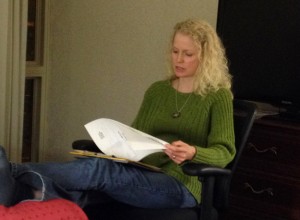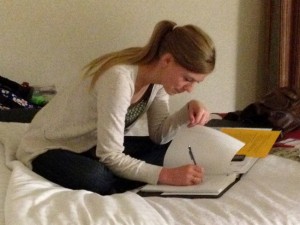If you’re a children’s book writer, one of the best ways to hone your craft is to attend your regional Society of Children’s Book Writers & Illustrators (SCBWI) conferences. For instance: the 2013 Iowa SCBWI Conference offered a variety of hands-on manuscript development opportunities:
- Roundtable Peer Critiques
- First Page Readings
- Manuscript Reviews
Roundtable Peer Critiques
Conference peer reviews provide fresh, unbiased feedback for our work-in-progress. Also, they widen our circle of writing friends, broaden our view of the world, and challenge us to write at a higher level.
For the peer critiques Iowa SCBWI Assistant Regional Advisor Lisa Morlock divided the manuscripts by genre, then she organized us into groups of four or five. Lisa emailed the manuscripts to each pertaining group member so we could review and print critiques (or bring them in e-form) before the conference.
Accomplished author Sharelle Byars Moranville facilitated my group, which consisted of three other chapter book and middle grade novelists. To top off the great advice we received from one another, she suggested we give all characters a crucible moment; deliver the empathy-building essence of our protagonists; and strategically plan for pivotal stepping moments at the quarter point, the mid point, and the three-quarter point of our manuscripts before tying it up with that satisfying ending.
First Page Readings
Michelle Poploff, Vice President and Executive Director of Delacorte Press Books for Young Readers, led “Finding Your Voice”, a session where First Page participants received a wealth of feedback in minutes. Participant names were randomly drawn. They read the first 500 words of their manuscripts. After each reading, attendees in the audience provided anonymous comments on notecards.
In our motel room the night before, my roommates and I took turns rehearsing and creating one-line elevator pitch synopses. Not only did the pitch-writing exercise equip all four of us to create more impactful queries; but the extra preparation paid off in the performances. When my roommates names were drawn, they delivered self-assured readings preceded by convincing pitches.
Manuscript Critiques
Face-to-face manuscript critiques provided the best opportunity to have our most polished, unpublished manuscript critiqued by an editor, agent, or published author. We submitted our manuscripts three to four weeks prior to the conference to allow ample time for our advisor to review and write comments; then we received a ten-minute appointment for them to tell us what worked, what didn’t, and how to improve our work.
Thanks to Joanna Cardenas, Assistant Editor for Viking Children’s Books, for reviewing my manuscript. She devoted an impressive amount of thoughtful consideration, offering suggestions on character development, plot and structure, language and diction, voice, and marketability. Her advice differed substantially from input I had received from Barry Goldblatt, founder of BG Literary, at the 2013 Minnesota Conference. However, their foundational goals remained the same: to increase my protagonist’s likeability, which would increase the appeal of my manuscript, which would increase its chances of being published. I’m grateful to them both.
Next week I’ll share more 2013 IA Conference wisdom from Michelle Poploff; Allison Remcheck, Assistant Literary Agent of Rosemary Stimola Literary Studio; Joanna Cardenas; and Jennifer Black Reinhardt. See you then!





